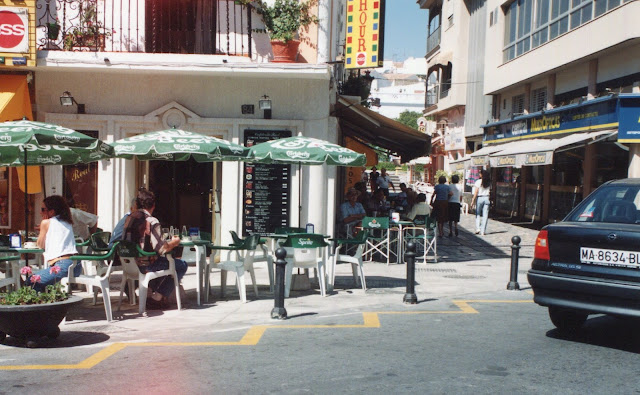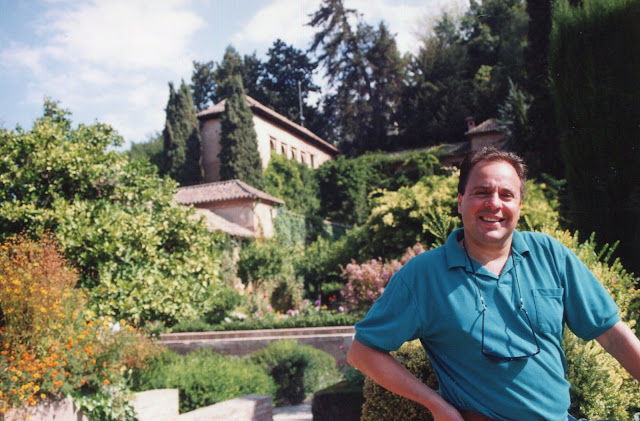The last part of Spain to be reconquered by
the Christian Spanish in the late 15th century, the province of Andalucia includes the
colourful inland cities of Seville, Cordoba & Granada that each have their
share of stunning Moorish architecture and semi-preserved historic barrios, the
Costa del Sol, with its miles of beautiful coastline and beachside resort towns
made to order for sun worshippers, and a vast in-between of pleasant
countryside, or “campo” dotted with charming little white villages dating back
to Roman times, that supports a more traditional rural lifestyle.
With family & friends in Estepona, we
had the perfect excuse to visit this region, and a good centrally located base
from which to conduct our various explorations.
Coming from Canada, the sun drenched topless beaches filled with nicely
browned flesh were particularly attractive, and each had its own bar that
served up plenty of drinks, music and good food. A good way to unwind for a few days and
forget about all the stress of life back home.
But the Spanish clock takes a little getting used to with siesta time
shutting down all the shops in the afternoon while everyone naps after their
big lunchtime dinner, and then eating again late at night and drinking till the
wee hours of the morning.
The town of Estepona itself is a typical Spanish village with its maze of cobblestone streets and shade trees filled with homes, shops, and outdoor restaurants serving paella, the signature national dish. As a fishing village it also has the daily catch on display at the market where fresh produce and other goods are being offered for sale.
Only a few minutes drive from the beach and
suddenly you are in the campo where life is much quieter and herds of sheep and
goats are more likely to cross your path than any tourists. This is the real
Spain, and where you find the ventas that serve up huge portions of delicious
food and bottles of local wine for half the price of any beach bar.
Another nice feature of the campo are the
amazingly picturesque little white villages strung out along the hillsides and
connected to one another by a maze of narrow, poorly signposted roads. Many of them original Roman forts, they serve
as a stunning counterpart to the ugly suburban sprawl so common to North
American life. Here the people have
preserved the countryside for farming, and rejected the tasteless mis-matched
housing designs of individual choice for a uniform colour and style that suits
the surroundings and makes for beautiful, close knit communities.
White villages life means the rocky soil makes for excellent wall building material but is virtually impossible to dig into so the graves are all above ground. Manual work is hard labour and in the morning the men show up at the hotel for their coffee & sambuca and perhaps a deep fried churro before starting the day.
Heading inland now the first stop was Seville. Though the Guadalquivir river has long since silted up and deprived Seville of its former principal port status, the grandeur of an earlier age is still more than evident, and the river is a pleasant dividing line between the old and new halves of the city. Centered around the Torre del Oro, a building formerly used to store all the plundered gold & silver from the New World, are a selection of little boats for hire and all the tour buses. It's also home to the Plaza de Espana and the entrance to all of the city's principal attractions.
It is in the old city where you find the
world’s largest Gothic church, the Cathedral of Seville, bigger than St. Paul’s
in London or St. Peter’s in Rome.
Overwhelming in its size and grandeur, one of the items that
particularly stands out is the carved alterpiece of 45 Biblical scenes that
represents the entire lifetime work of one artist. A dedication that is unimaginable
in today’s world. Also found in the
church is a monument to Christopher Columbus, and the tomb which contains his
remains.
The second principal monument of the city
is the Giralda, a former Moorish minaret that is now a Christian bell tower for
the cathedral. An ascending series of
wide ramps takes you to the top of the building for an incredible view of the
city.
The last of the main monuments is the
Alcazar, a former palace, started in Roman times and expanded on through
successive generations of Moorish rulers and Christian kings. But the best part of this complex are the
beautiful gardens, with their eclectic mix of styles, that provide a
wonderfully cool and peaceful respite from the heat.
But the real action is in the Barrio Santa
Cruz, with its marvellously confusing maze of streets and alleyways, decorated
in beautiful mosaic tile work, and filled with little shops, charming pensions,
and famous tapas bars. Cars are a
hopeless encumbrance in this area, and it was a relief to store our vehicle in
a public car park, and go out exploring on foot.
Of course the principal attraction are the tapas bars with their amazing variety of appetizers & sherries. We visited many, but on our last night Junie and I feasted at the “Modesto” delighted to be among so many other people enjoying a perfect evening.
The funky, commercialized old quarter in Cordoba
is known as the Juderia. Not as vibrant
as Seville, but very colourful with the finely decorated patios that abound
here thanks to an annual competition. It’s also where we got our first lesson
in sherry appreciation, courtesy of a fabulous restaurant bodega.
Perhaps the most interesting time we had
was getting up early in the morning to head out of town and check out the
excavation and restoration of yet another old Moorish palace complex and mosque
known as the Medina Azahara. More than
1,300 years after it was given the name “al Andalus” by the first wave of North
African settlers, the Moorish connection is still very evident.
But the most precious monument of all
Andalucia is found in Granada, and that of course is the Alhambra. Arriving late in the afternoon, following a
seemingly endless journey through Spanish olive groves, we checked into our
splendid, faded old gem of a hotel, the Washington Irving, named after the
author of the famous “Tales of the Alhambra”. Spent the rest of the day wandering around the old Moorish
quarter, known as the Albacin, and had a superb dinner in a restaurant with a
view of the Alhambra all lit up at night.
The next morning we were practically first in line to tour the complex, which consists of the Royal Palace and the gardens known as the Generalife. Entering through the “Gate of Justice” a magnificent tower with a giant key shaped arch, (the Muslim symbol for Allah, the opener of the gates of Paradise) we began our tour. How to describe all the intricate ornamentation and decoration done in tile, wood and plaster, the interesting pools and fountains mingled amongst all the various salons, each with its own storied and often terrible history? A fascinating place.
The Alhambra is also perfect for a view of
Granada and the Albacin area, (why else would it have been made into a
fortress) and its beautiful, tranquil
gardens are rivalled only by those of the Alcazar in Seville.
And when you are tired and thirsty from all
the walking and picture taking, what could be better than tapas and a beer at a
table in the Plaza Nueva down below?
And that's Andalucia in a nutshell; centuries of Roman ruins, lots of Moorish architectural influence, and white villages dotting the hillsides. Too much sunshine, miles of beaches and golf courses, and everywhere you go great food and wine.








































































































Instead of utilizing real-life currency, House of Fun slot machines use in-game cash and merchandise collections only. When our 먹튀사이트 먹튀프렌즈3 Funsters play our free slots for fun, there are not any actual wagers going down. Every single transaction takes place inside the sport, with no actual cash required. House of Fun has transformed on-line slot machine gaming into a free-for-all and fascinating expertise. For occasion, the bonus could take the form of free spins, pick-a-prize interactions, or mystery bonuses.
ReplyDelete